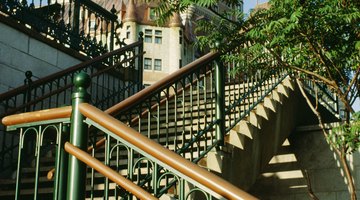How to Use Rebar for Railing
Rebar, or steel reinforcement bar, is normally put inside forms to add tensile strength to poured concrete. The steel is sold in long rod lengths, and is ribbed along its edges to allow the concrete a better surface to adhere to.

Using rebar in any application by itself will certainly be cheap, but can also be made to look beautiful. Using rebar for the upright supports in a hand railing is a an innovative application.
Things You Will Need
- Angle grinder
- Drill
- Paint
-
Determine the design and spacing for your upright handrail supports. Check your local building codes for the specifics on what is permitted in your area. Most railings must have vertical supports spaced no more than 4 inches apart, and must be oriented vertically so that children cannot climb up the supports. For purposes of explanation, these instructions are for a 10 foot length of stairway railing at an incline of 10 degrees, with a total railing height of 40 inches.
-
Cut your rebar into 39 inch lengths to correspond to the height of the hand rail, using an angle grinder.
-
Drill holes along the bottom rail of your staircase railing. These are insertion points for the rebar. Space the holes no more than 4 inches apart and drill vertically into the base of the railing, not perpendicular to it, as the stairway is angled.
-
Drill corresponding holes in the underside of your hand railing. These holes need only be 1/2 inch deep, to hold the ends of the rebar in place. The spacing and angle of the holes should correspond to the holes drilled in the base of the railing. Use a 4-foot level to assure the holes are aligned vertically.
-
Place the ends of your cut rebar into the holes you have drilled in the base of the railing, then fit the upright ends into the corresponding holes drilled into the underside of your wooden handrail. As rebar is somewhat flexible, you'll want to add a structural support, called a newel post, at either end of the railing. If the rebar pieces are loose, add a drop of silicone into the hole.
-
Paint the rebar sections. Whether used indoors or out, rebar will rust over time if left untreated. Paint using a rust inhibiting paint.
The Drip Cap
- Rebar, or steel reinforcement bar, is normally put inside forms to add tensile strength to poured concrete.
- The steel is sold in long rod lengths, and is ribbed along its edges to allow the concrete a better surface to adhere to.
- Determine the design and spacing for your upright handrail supports.
- Drill holes along the bottom rail of your staircase railing.
- These holes need only be 1/2 inch deep, to hold the ends of the rebar in place.
References
Writer Bio
Brandy Alexander began writing professionally in 1993. She has years of experience as a professional of the English language employed with the "Cape Times" and "The Mercury." Alexander holds a master's degree in English literature from Stellenbosch University in South Africa.
Photo Credits
- Photos.com/Photos.com/Getty Images
- Photos.com/Photos.com/Getty Images
More Articles



